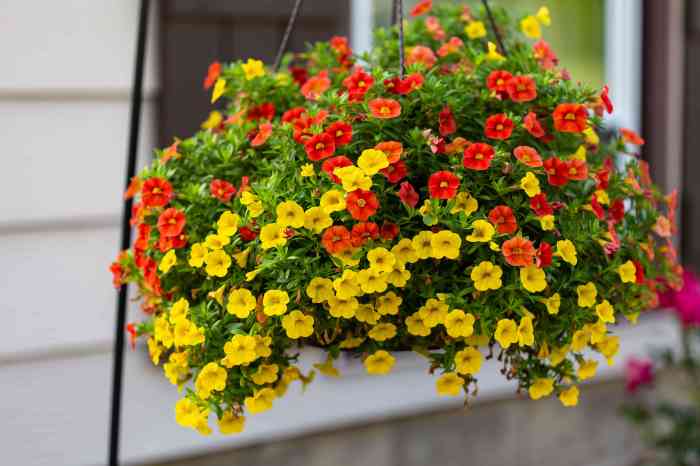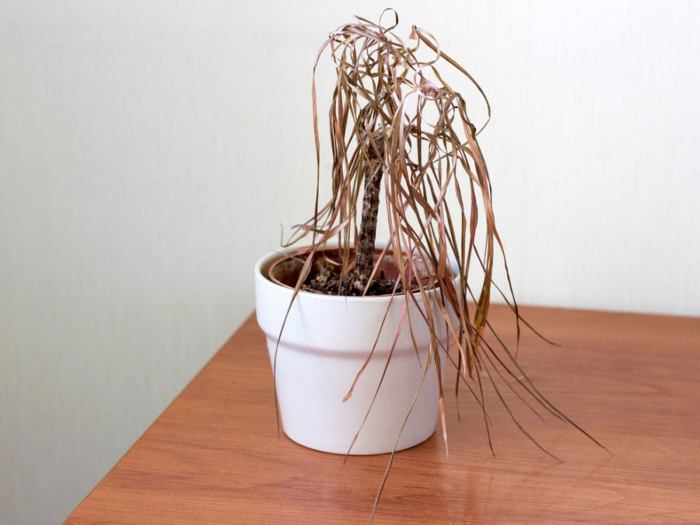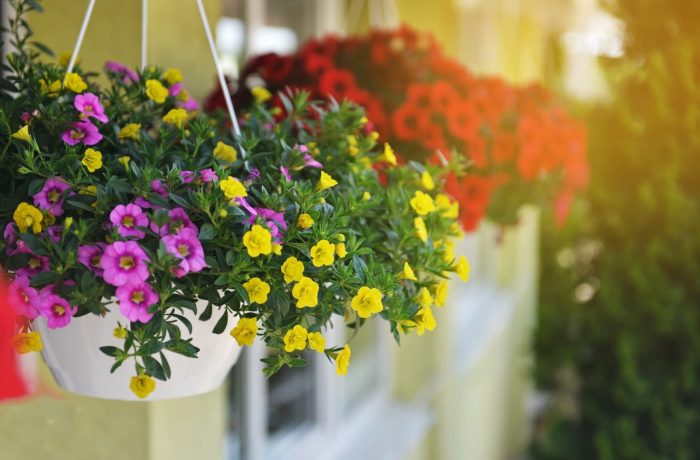Hanging basket plants dying is a common problem that can be caused by a variety of factors, including insufficient watering, lack of sunlight, pests, diseases, and nutrient deficiencies. By understanding the common causes of decline and implementing corrective measures, you can help your hanging basket plants thrive.
To assess the health of your hanging basket plants, look for signs of stress or decline, such as wilting, yellowing leaves, stunted growth, and insect damage. Once you have identified the cause of the decline, you can take steps to address the issue and restore your plants to health.
Identifying Common Causes of Dying Hanging Basket Plants

Hanging basket plants bring beauty and life to outdoor spaces, but they can also be susceptible to various factors that lead to their decline. Understanding these common causes is crucial for proper care and maintaining the health of hanging basket plants.
Insufficient Watering
Insufficient watering is a primary cause of dying hanging basket plants. The frequency of watering depends on factors such as the plant species, sunlight exposure, and weather conditions. However, general guidelines suggest watering hanging baskets thoroughly when the soil surface feels dry to the touch.
Signs of underwatering include wilting, dry soil, and yellowing leaves.
Lack of Sunlight
Hanging basket plants require adequate sunlight for photosynthesis and growth. Insufficient sunlight can lead to stunted growth, weak stems, and yellowing leaves. Plants placed in shaded areas may benefit from supplemental lighting or relocation to a sunnier spot.
Hanging basket plants dying in the cold weather can be disheartening, but there are ways to keep them thriving even in the colder months. Consider switching to hanging basket plants for autumn and winter , which are more resilient to cooler temperatures and can provide a splash of color to your outdoor space.
However, if you notice your existing hanging basket plants struggling, remember that proper care, including adequate watering and protection from extreme cold, can help them survive the winter and return to their former glory in the spring.
Pests
Hanging basket plants can be affected by various pests, including aphids, mealybugs, and spider mites. These pests feed on plant sap, causing damage to leaves and stems. Early detection and treatment are essential to prevent severe infestations.
If you’re struggling to keep your hanging basket plants alive, you’re not alone. Many factors can contribute to the death of these plants, including improper watering, lack of sunlight, and pests. If you’re looking for a way to revive your hanging plants, consider investing in hanging plant pots indoor uk . These pots are designed to provide your plants with the support and drainage they need to thrive.
With a little care and attention, you can get your hanging basket plants back to their former glory.
Diseases
Hanging basket plants can also succumb to diseases caused by fungi, bacteria, or viruses. Symptoms vary depending on the disease, but may include leaf spots, wilting, and stunted growth. Proper sanitation and preventive measures, such as using clean potting mix and avoiding overwatering, can help minimize disease risk.
Nutrient Deficiencies
Hanging basket plants require a balanced supply of nutrients for optimal growth. Nutrient deficiencies can occur due to depleted soil or improper fertilization. Symptoms of nutrient deficiencies vary depending on the specific nutrient lacking, but may include stunted growth, yellowing leaves, and poor flowering.
Assessing the Health of Hanging Basket Plants

Regularly assessing the health of hanging basket plants is crucial for their longevity and vibrancy. By inspecting the plants closely, you can identify early signs of stress or decline and take prompt action to address the underlying issues.
Here are some visual cues to look for when assessing the health of hanging basket plants:
Wilting
- Wilting, characterized by drooping leaves that lack turgidity, can indicate dehydration, excessive heat, or root damage.
Yellowing Leaves
- Yellowing leaves, particularly older ones, may indicate nutrient deficiencies, overwatering, or root rot.
- Iron deficiency, in particular, can cause yellowing between leaf veins, while nitrogen deficiency leads to overall yellowing.
Stunted Growth
- Stunted growth, where new leaves are smaller than usual, can be a sign of nutrient deficiency, rootbound roots, or inadequate sunlight.
Insect Damage
- Inspect for pests such as aphids, spider mites, or mealybugs, which can cause damage to leaves and stems.
- Look for signs of insect activity, such as holes in leaves, webbing, or sticky residue.
Implementing Corrective Measures

Reviving ailing hanging basket plants requires a comprehensive approach that addresses the underlying causes of decline. This involves adjusting watering schedules, optimizing sunlight exposure, combating pests and diseases, and addressing nutrient deficiencies.
Adjusting Watering Schedules
Overwatering and underwatering are common culprits in hanging basket plant decline. Establish a regular watering schedule that provides adequate moisture without causing waterlogging. Check the soil moisture by inserting a finger into the potting mix. If the top inch feels dry, it’s time to water.
Optimizing Sunlight Exposure
Most hanging basket plants thrive in bright, indirect light. However, excessive sunlight can scorch leaves, while insufficient light can hinder growth. Assess the light conditions in the hanging basket’s location and adjust accordingly. Consider moving the plant to a more shaded or sunnier spot as needed.
Treating Pests and Diseases
Pests and diseases can wreak havoc on hanging basket plants. Regularly inspect the plants for signs of infestation or infection. Treat any infestations promptly with appropriate pesticides or insecticidal soap. Fungal diseases can be managed with fungicides. Neem oil or horticultural oil can serve as natural pest repellents.
Addressing Nutrient Deficiencies
Nutrient deficiencies can manifest as yellowing leaves, stunted growth, or poor flowering. Fertilize hanging basket plants regularly with a balanced liquid fertilizer. Follow the instructions on the fertilizer label carefully to avoid over-fertilization. Consider using organic fertilizers such as compost tea or fish emulsion.
Designing a Comprehensive Care Plan

To ensure the thriving growth and vitality of hanging basket plants, it is imperative to establish a comprehensive care plan that encompasses proper watering techniques, fertilization schedules, and optimal growing conditions. By adhering to these guidelines, you can create a flourishing environment for your hanging baskets, allowing them to showcase their beauty and enhance your outdoor space.
Hanging basket plants can be a beautiful addition to any home, but they can also be difficult to keep alive. If you’re struggling to keep your hanging basket plants from dying, there are a few things you can do. First, make sure that you’re providing your plants with the right amount of light, water, and fertilizer.
You can also check out our guide to hanging basket plant care for more tips on how to keep your plants healthy and thriving. Even with proper care, hanging basket plants can sometimes die due to various factors such as overwatering, underwatering, pests, or diseases.
It’s essential to monitor your plants regularly and address any issues promptly to prevent further damage.
Watering Frequency
The frequency of watering for hanging basket plants depends on several factors, including the type of plant, the size of the basket, the weather conditions, and the drainage of the soil. As a general rule, hanging baskets require more frequent watering than plants in the ground due to their limited soil capacity.
During hot, dry weather, you may need to water your hanging baskets daily or even twice a day. In cooler, wetter weather, you can reduce the frequency of watering to every few days.
Fertilization Schedule
Fertilizing hanging basket plants regularly is essential for providing them with the nutrients they need for healthy growth. A balanced fertilizer, such as a 10-10-10 or 20-20-20, can be used every two to four weeks during the growing season. Be sure to follow the instructions on the fertilizer label carefully to avoid over-fertilizing, which can damage the plants.
Optimal Growing Conditions
Hanging basket plants thrive in well-drained soil that is rich in organic matter. They also need plenty of sunlight, so choose a location that receives at least six hours of sunlight per day. If you are growing your hanging baskets in a shady area, you may need to supplement with artificial light.
Troubleshooting Specific Issues
Hanging basket plants can face various issues that affect their health and appearance. To ensure optimal growth and prevent decline, it’s crucial to identify and address these problems promptly.
Common issues encountered with hanging basket plants include leaf scorch, root rot, and pest infestations. Understanding the causes and implementing effective solutions can help restore the health of these plants and enhance their aesthetic appeal.
Leaf Scorch, Hanging basket plants dying
Leaf scorch, characterized by brown or yellow patches on leaves, occurs when plant tissues are damaged due to excessive sunlight, heat, or drought. To prevent leaf scorch, provide shade during intense sunlight, water regularly to maintain adequate soil moisture, and fertilize according to the plant’s specific needs.
Root Rot
Root rot, caused by excessive moisture or poor drainage, leads to the decay of plant roots. Symptoms include wilting, yellowing leaves, and stunted growth. To address root rot, reduce watering frequency, improve drainage by amending the soil with perlite or vermiculite, and remove any dead or diseased roots.
Pest Infestations
Pest infestations, such as aphids, mealybugs, or spider mites, can weaken hanging basket plants and damage their foliage. To control pests, use insecticidal soap or neem oil, remove infested leaves, and encourage beneficial insects that prey on pests.
Conclusive Thoughts
With proper care and maintenance, hanging basket plants can provide years of beauty and enjoyment. By following the tips Artikeld in this guide, you can help your hanging basket plants thrive and add a touch of greenery to your home.
FAQ Insights: Hanging Basket Plants Dying
What are the most common causes of hanging basket plants dying?
The most common causes of hanging basket plants dying include insufficient watering, lack of sunlight, pests, diseases, and nutrient deficiencies.
How can I tell if my hanging basket plants are dying?
Signs of decline in hanging basket plants include wilting, yellowing leaves, stunted growth, and insect damage.
What can I do to save my dying hanging basket plants?
To save your dying hanging basket plants, you need to identify the cause of the decline and take steps to address the issue. This may include adjusting watering schedules, optimizing sunlight exposure, treating pests and diseases, and addressing nutrient deficiencies.